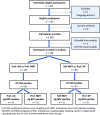Anterior nasal versus nasal mid-turbinate sampling for a SARS-CoV-2 antigen-detecting rapid test: does localisation or professional collection matter?
- PMID: 34445926
- PMCID: PMC8425459
- DOI: 10.1080/23744235.2021.1969426
Anterior nasal versus nasal mid-turbinate sampling for a SARS-CoV-2 antigen-detecting rapid test: does localisation or professional collection matter?
Abstract
Introduction: Most SARS-CoV-2 antigen-detecting rapid diagnostic tests require nasopharyngeal sampling, which is frequently perceived as uncomfortable and requires healthcare professionals, thus limiting scale-up. Nasal sampling could enable self-sampling and increase acceptability. The term nasal sampling is often not used uniformly and sampling protocols differ.
Methods: This manufacturer-independent, prospective diagnostic accuracy study, compared professional anterior nasal and nasal mid-turbinate sampling for a WHO-listed SARS-CoV-2 antigen-detecting rapid diagnostic test. The second group of participants collected a nasal mid-turbinate sample themselves and underwent a professional nasopharyngeal swab for comparison. The reference standard was real-time polymerase chain reaction (RT-PCR) using combined oro-/nasopharyngeal sampling. Individuals with high suspicion of SARS-CoV-2 infection were tested. Sensitivity, specificity, and percent agreement were calculated. Self-sampling was observed without intervention. Feasibility was evaluated by observer and participant questionnaires.
Results: Among 132 symptomatic adults, both professional anterior nasal and nasal mid-turbinate sampling yielded a sensitivity of 86.1% (31/36 RT-PCR positives detected; 95%CI: 71.3-93.9) and a specificity of 100.0% (95%CI: 95.7-100). The positive percent agreement was 100% (95%CI: 89.0-100). Among 96 additional adults, self nasal mid-turbinate and professional nasopharyngeal sampling yielded an identical sensitivity of 91.2% (31/34; 95%CI 77.0-97.0). Specificity was 98.4% (95%CI: 91.4-99.9) with nasal mid-turbinate and 100.0% (95%CI: 94.2-100) with nasopharyngeal sampling. The positive percent agreement was 96.8% (95%CI: 83.8-99.8). Most participants (85.3%) considered self-sampling as easy to perform.
Conclusion: Professional anterior nasal and nasal mid-turbinate sampling are of equivalent accuracy for an antigen-detecting rapid diagnostic test in ambulatory symptomatic adults. Participants were able to reliably perform nasal mid-turbinate sampling themselves, following written and illustrated instructions. Nasal self-sampling will facilitate scaling of SARS-CoV-2 antigen testing.
Keywords: COVID-19; SARS-CoV-2; anterior nasal; antigen-detecting rapid test; nasal mid-turbinate; nasal-sampling; self-sampling.
Conflict of interest statement
No potential conflict of interest was reported by the author(s).
References
-
- European Centre for Disease Prevention and Control . Options for the use of rapid antigen tests for COVID-19 in the EU/EEA and the UK. November 19 2020; [cited 2021 Mar 8]. Available from: https://www.ecdc.europa.eu/en/publications-data/options-use-rapid-antige....
-
- European Centre for Disease Prevention and Control . Surveillance of COVID-19 at long-term care facilities in the EU/EEA. May 19 2020; [cited 2021 Mar 8]. Available from: https://www.ecdc.europa.eu/en/publications-data/surveillance-COVID-19-lo....
-
- CDC . Interim Guidelines for Collecting, Handling, and Testing Clinical Specimens for COVID-19.; [cited 2021 Mar 8]. Available from: https://www.cdc.gov/coronavirus/2019-ncov/lab/guidelines-clinical-specim....
Publication types
MeSH terms
LinkOut - more resources
Full Text Sources
Other Literature Sources
Medical
Miscellaneous

